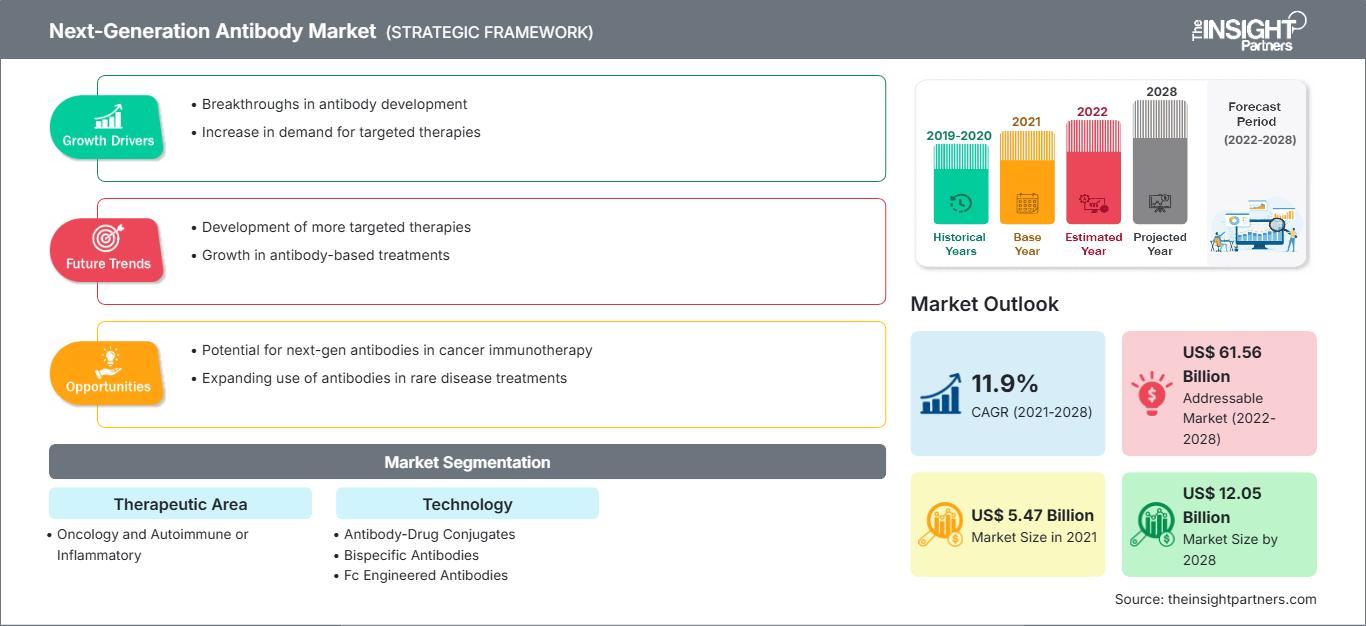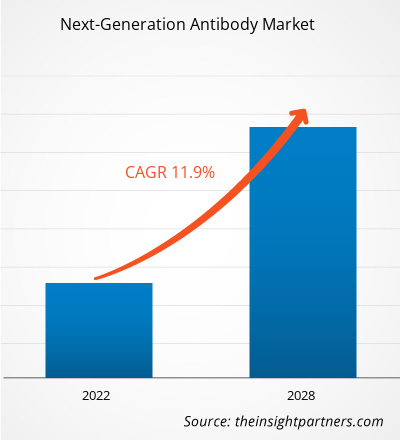Si prevede che il mercato degli anticorpi di nuova generazione raggiungerà i 12.050,13 milioni di dollari entro il 2028, rispetto ai 5.468,41 milioni di dollari del 2021; si stima una crescita a un CAGR dell'11,9% dal 2021 al 2028.
Gli anticorpi di nuova generazione sono progettati per essere più specifici e spesso più potenti dei tradizionali anticorpi monoclonali. Le strategie per anticorpi di nuova generazione sono necessarie per progettare una terapia efficace che combini anticorpo, carico utile, linker e metodo di coniugazione, garantendo al contempo stabilità, somministrazione mirata e limitati effetti off-target.
Il rapporto offre approfondimenti e analisi approfondite del mercato degli anticorpi di nuova generazione, evidenziando vari parametri come tendenze di mercato, progressi tecnologici, dinamiche di mercato e analisi del panorama competitivo dei principali attori del mercato a livello mondiale. Include anche l'impatto della pandemia di COVID-19 sul mercato in tutte le regioni. La pandemia ha sconvolto le condizioni socioeconomiche di diversi paesi in tutto il mondo. Attualmente, gli Stati Uniti sono il Paese più colpito al mondo dall'epidemia di COVID-19, con il più alto numero di casi confermati e decessi al mondo, secondo le recenti statistiche dell'OMS. L'elevato numero di casi positivi al COVID-19 ha avuto un impatto negativo sulle economie globali. Si è registrato un calo delle attività commerciali complessive e una crescita di vari settori industriali operanti a livello globale.
Personalizza questo rapporto in base alle tue esigenze
Potrai personalizzare gratuitamente qualsiasi rapporto, comprese parti di questo rapporto, o analisi a livello di paese, pacchetto dati Excel, oltre a usufruire di grandi offerte e sconti per start-up e università
Mercato degli anticorpi di nuova generazione: Approfondimenti strategici

-
Ottieni le principali tendenze chiave del mercato di questo rapporto.Questo campione GRATUITO includerà l'analisi dei dati, che vanno dalle tendenze di mercato alle stime e alle previsioni.
L'epidemia di COVID-19 ha gravato in modo ingente sulle infrastrutture sanitarie di Stati Uniti, Canada e Messico. Inoltre, la maggior parte delle aziende farmaceutiche e biotecnologiche e degli istituti di ricerca è impegnata nello sviluppo di vaccini e farmaci contro il COVID-19. Sia le grandi aziende farmaceutiche che le piccole startup si sono fatte avanti per sviluppare trattamenti e vaccini mirati all'infezione causata dal nuovo coronavirus. Di conseguenza, le attività di ricerca sui vaccini nelle aziende farmaceutiche e biotecnologiche, nei centri di ricerca e negli istituti di ricerca educativa sono riconosciute essenziali e non hanno subito praticamente alcuna incidenza in termini di operatività e produzione. Tuttavia, a causa dell'aumento delle attività di ricerca, si prevede che cresceranno sia l'accessibilità ai finanziamenti per la ricerca sia la necessità di anticorpi, compresi quelli di nuova generazione. Inoltre, a seguito dell'epidemia di COVID-19, molti ricercatori in tutto il mondo sono impegnati nell'analisi virale del SARS-CoV-2, il virus che causa il COVID-19. Sia per i vaccini che per le terapie, gli anticorpi generati vengono esaminati per la loro efficacia funzionale nel contrastare il virus bersaglio. Pertanto, si prevede che la pandemia di COVID-19 avrà un impatto positivo sul mercato degli anticorpi di nuova generazione nei prossimi anni.
In base alla regione, il mercato degli anticorpi di nuova generazione è segmentato in Nord America, Europa, Asia-Pacifico, Medio Oriente e Africa e America meridionale e centrale.
Approfondimenti di mercato
La crescente domanda di terapie con anticorpi di nuova generazione guiderà il mercato degli anticorpi di nuova generazione
I crescenti sviluppi nel campo delle biotecnologie hanno portato a una crescente accettazione delle terapie con anticorpi di nuova generazione, che ne sta promuovendo l'utilizzo nel trattamento di malattie autoimmuni, infiammatorie e croniche. Le terapie con anticorpi di nuova generazione sono il risultato dell'applicazione di tecnologie sofisticate, come i coniugati farmaco-anticorpo (ADC), gli anticorpi glicoingegnerizzati e gli anticorpi specifici (BsAb). Pertanto, le applicazioni degli anticorpi di nuova generazione sono ampiamente studiate per il trattamento di varie malattie croniche come cancro, HIV, malattie infettive, ecc. La crescente domanda di questi anticorpi ha portato a un rapido aumento dell'approvazione di ADC e di altre terapie basate su anticorpi di nuova generazione. Ad esempio, a maggio 2020, Takeda Pharmaceutical Company Limited ha annunciato l'approvazione da parte della FDA di ALUNBRIG (brigatinib) per pazienti adulti con carcinoma polmonare non a piccole cellule (NSCLC) metastatico positivo alla chinasi del linfoma anaplastico (ALK+), rilevato da un test approvato dalla FDA. L'attuale indicazione di ALUNBRIG è stata ampliata con la sua approvazione per includere il trattamento di prima linea. ALUNBRIG è un inibitore della tirosin-chinasi (TKI) di nuova generazione progettato per colpire le anomalie molecolari di ALK. Analogamente, nel 2019, Genentech ha annunciato l'approvazione accelerata da parte della FDA di Polatuzumab vedotin-piiq, un coniugato farmaco-anticorpo diretto contro CD79b indicato in combinazione con bendamustina e un prodotto a base di rituximab per pazienti adulti con linfoma diffuso a grandi cellule B recidivante o refrattario.
Pertanto, si prevede che il mercato degli anticorpi di nuova generazione crescerà rapidamente durante il periodo di previsione grazie all'aumento delle approvazioni degli studi clinici e all'elevata adozione di terapie basate su anticorpi di nuova generazione per il trattamento di varie patologie.
Approfondimenti basati sull'area terapeutica
In base all'area terapeutica, il mercato degli anticorpi di nuova generazione si divide in oncologia e malattie autoimmuni o infiammatorie. Il segmento oncologico ha rappresentato una quota maggiore del mercato.
Approfondimenti basati sulla tecnologia
In base alla tecnologia, il mercato degli anticorpi di nuova generazione è segmentato in coniugati anticorpo-farmaco, anticorpi bispecifici, anticorpi ingegnerizzati Fc, frammenti di anticorpi e proteine simil-anticorpo e prodotti anticorpali biosimilari. Il segmento dei coniugati anticorpo-farmaco ha detenuto la quota maggiore del mercato nel 2021 e si stima che lo stesso segmento registrerà il CAGR più elevato del 12,1% nel mercato durante il periodo di previsione.
Gli operatori del mercato degli anticorpi di nuova generazione adottano diverse strategie organiche, come il lancio e l'espansione dei prodotti, per espandere la propria presenza e il portafoglio prodotti a livello mondiale e soddisfare la crescente domanda.
Anticorpi di nuova generazione
Approfondimenti regionali sul mercato degli anticorpi di nuova generazione
Le tendenze regionali e i fattori che influenzano il mercato degli anticorpi di nuova generazione durante il periodo di previsione sono stati ampiamente spiegati dagli analisti di The Insight Partners. Questa sezione illustra anche i segmenti e la geografia del mercato degli anticorpi di nuova generazione in Nord America, Europa, Asia-Pacifico, Medio Oriente e Africa, America Meridionale e Centrale.
Ambito del rapporto sul mercato degli anticorpi di nuova generazione
| Attributo del rapporto | Dettagli |
|---|---|
| Dimensioni del mercato in 2021 | US$ 5.47 Billion |
| Dimensioni del mercato per 2028 | US$ 12.05 Billion |
| CAGR globale (2021 - 2028) | 11.9% |
| Dati storici | 2019-2020 |
| Periodo di previsione | 2022-2028 |
| Segmenti coperti |
By Area Terapeutica
|
| Regioni e paesi coperti |
Nord America
|
| Leader di mercato e profili aziendali chiave |
|
Densità degli operatori del mercato degli anticorpi di nuova generazione: comprendere il suo impatto sulle dinamiche aziendali
Il mercato degli anticorpi di nuova generazione è in rapida crescita, trainato dalla crescente domanda degli utenti finali, dovuta a fattori quali l'evoluzione delle preferenze dei consumatori, i progressi tecnologici e una maggiore consapevolezza dei benefici del prodotto. Con l'aumento della domanda, le aziende stanno ampliando la propria offerta, innovando per soddisfare le esigenze dei consumatori e sfruttando le tendenze emergenti, alimentando ulteriormente la crescita del mercato.

- Ottieni il Mercato degli anticorpi di nuova generazione Panoramica dei principali attori chiave
Profili aziendali
- F. HOFFMANN-LA ROCHE LTD.
- Kyowa Kirin Co., Ltd.
- Seagen Inc.
- ImmunoGen, Inc.
- Takeda Pharmaceutical Company Limited
- Amgen Inc.
- Pfizer Inc.
- Catalent Inc
- AstraZeneca
- Xencor
- Analisi storica (2 anni), anno base, previsione (7 anni) con CAGR
- Analisi PEST e SWOT
- Valore/volume delle dimensioni del mercato - Globale, Regionale, Nazionale
- Industria e panorama competitivo
- Set di dati Excel
Report recenti
Testimonianze
Motivo dell'acquisto
- Processo decisionale informato
- Comprensione delle dinamiche di mercato
- Analisi competitiva
- Analisi dei clienti
- Previsioni di mercato
- Mitigazione del rischio
- Pianificazione strategica
- Giustificazione degli investimenti
- Identificazione dei mercati emergenti
- Miglioramento delle strategie di marketing
- Aumento dell'efficienza operativa
- Allineamento alle tendenze normative






















 Ottieni un campione gratuito per - Mercato degli anticorpi di nuova generazione
Ottieni un campione gratuito per - Mercato degli anticorpi di nuova generazione